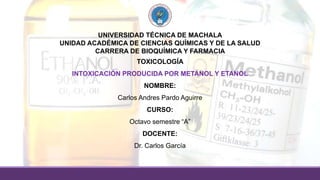INTOXICACIÓN PRODUCIDA POR METANOL Y ETANOL
•Descargar como PPTX, PDF•
0 recomendaciones•21 vistas
METANOL Y ETANOL
Denunciar
Compartir
Denunciar
Compartir

Más contenido relacionado
La actualidad más candente
La actualidad más candente (20)
Similar a INTOXICACIÓN PRODUCIDA POR METANOL Y ETANOL
Similar a INTOXICACIÓN PRODUCIDA POR METANOL Y ETANOL (20)
intoxicacion por alcoholes (etilico y metilico) y cianuro.pptx

intoxicacion por alcoholes (etilico y metilico) y cianuro.pptx
Más de CarlosPardo76
Más de CarlosPardo76 (17)
PLAGUICIDAS, SUSTANCIAS TERATOGÉNICAS, MUTACIONES Y CARCINOGÉNICAS

PLAGUICIDAS, SUSTANCIAS TERATOGÉNICAS, MUTACIONES Y CARCINOGÉNICAS
INTOXICACIÓN PRODUCIDA POR HIDRÓXIDO DE SODIO E HIDRÓXIDO DE POTASIO 

INTOXICACIÓN PRODUCIDA POR HIDRÓXIDO DE SODIO E HIDRÓXIDO DE POTASIO
INTOXICACIÓN PRODUCIDA POR ÁCIDO SULFÚRICO Y ÁCIDO NÍTRICO 

INTOXICACIÓN PRODUCIDA POR ÁCIDO SULFÚRICO Y ÁCIDO NÍTRICO
INTOXICACIÓN PRODUCIDA POR ALUMINIO, COBALTO Y ZINC 

INTOXICACIÓN PRODUCIDA POR ALUMINIO, COBALTO Y ZINC
INTOXICACIÓN PRODUCIDA POR CADMIO, HIERRO, ARSÉNICO Y MERCURIO 

INTOXICACIÓN PRODUCIDA POR CADMIO, HIERRO, ARSÉNICO Y MERCURIO
INTOXICACIÓN PRODUCIDA POR CIANURO Y CIANUROS ALCALINOS

INTOXICACIÓN PRODUCIDA POR CIANURO Y CIANUROS ALCALINOS
Último
En esta última sesión planificada del Seminario se van a estudiar los temas siguientes:
Enfermedad de Parkinson: Epidemiología. Manifestaciones clínicas. Factores de riesgo. Mecanismos. Proteína α-synucleina. Sustancia negra. Dopamina. Biomarcadores. Prevención.Enfermedad de Parkinson. Enfermedades Neurológicas y Conducta

Enfermedad de Parkinson. Enfermedades Neurológicas y ConductaUniversidad Popular Carmen de Michelena
Último (20)
Esterilización-por-calor. Todo conpkwyooooooooooopdf

Esterilización-por-calor. Todo conpkwyooooooooooopdf
(2024-09-05) Mutilacion genital femenina (PPT).pptx

(2024-09-05) Mutilacion genital femenina (PPT).pptx
ACTIVIDAD 7. DCI y sinonimia de los medicamentos esenciales.pptx

ACTIVIDAD 7. DCI y sinonimia de los medicamentos esenciales.pptx
casos clínicos hidrocefalia que es tratamiento sintomas

casos clínicos hidrocefalia que es tratamiento sintomas
PATTON Estructura y Funcion del Cuerpo Humano (2).pdf

PATTON Estructura y Funcion del Cuerpo Humano (2).pdf
Enfermedad de Parkinson. Enfermedades Neurológicas y Conducta

Enfermedad de Parkinson. Enfermedades Neurológicas y Conducta
FARMCOCINÉTICA Y FARMACODINAMIA DE LOS MEDICAMENTOS TÓPICOS

FARMCOCINÉTICA Y FARMACODINAMIA DE LOS MEDICAMENTOS TÓPICOS
Benzodiazepinas en anestesiologia generalidades.pptx

Benzodiazepinas en anestesiologia generalidades.pptx
INTOXICACIÓN PRODUCIDA POR METANOL Y ETANOL
- 1. UNIVERSIDAD TÉCNICA DE MACHALA UNIDAD ACADÉMICA DE CIENCIAS QUÍMICAS Y DE LA SALUD CARRERA DE BIOQUÍMICA Y FARMACIA TOXICOLOGÍA INTOXICACIÓN PRODUCIDA POR METANOL Y ETANOL NOMBRE: Carlos Andres Pardo Aguirre CURSO: Octavo semestre “A” DOCENTE: Dr. Carlos García
- 2. METANOL El metanol (CH3OH) es un líquido incoloro y volátil a temperatura ambiente. Por sí mismo es inofensivo, pero sus metabolitos son tóxicos. Utilización industrial como disolvente, utilizándose en la fabricación de plásticos, material fotográfico La intoxicación se produce generalmente por ingesta accidental o intencionada. También se han dado casos de intoxicación por adulteración de bebidas alcohólicas. FUENTES DE EXPOSICIÓN
- 3. Se absorbe rápidamente a partir del tracto gastrointestinal Periodo de lactancia (40 minutos a 72 horas) Acidosis con anión gap elevado y de síntomas visuales TOXICOCINÉTICA
- 4. Perdida de agudeza visual Taquipnea Síntomas neurológicos Alteraciones hemodinámicas Acidosis metabólica CUADRO CLÍNICOMECANISMO DE ACCIÓN Se absorbe por vía oral a través de la piel, y por vía respiratoria. El hígado lo metaboliza en su mayor parte a través del alcohol- deshidrogenasa La vida media es de unas 12 horas, que puede reducirse a 2.5 mediante hemodiálisis.
- 5. ETANOL • Líquido incoloro e inflamable con un punto de ebullición de 78 °C • Su fórmula química es C2H5OH Formula estructural • Afectar al sistema nervioso central provocando estados de euforia • Su mayor potencial bactericida tiene a una concentración de aproximadamente el 70 % Toxicología
- 6. • Ocasionada por la ingestión masiva de alcohol Intoxicación Aguda • Intoxicaciones agudas repetidas o excesivas y continuadas Intoxicación Crónica Reacción de Schiff Reacción de Rimini Reacción de Marquis Reacción de Hehner RECONOCIMIENTO DE ETANOL